Menus
- Dynamic Ecotrail
- Discovery
- In the saddle
- In the city
- Motorway and expressways
- Departmental
- Part-cycle
- Braking
- Comfort / Duo
- Consumption
- Conclusion
- Availablity
- Colors
- Accessories
Dynamic Ecotrail
Since 2011, the NC700 family has been trying to respond, each according to their specificities in the daily life of mostly peri-urban bikers. With the X model that appeared in 2012, Honda wanted to provide the most complete response to the demands of urban and peri-urban bikers.. An equation in X to solve the quadrature of the circle. Under its urban trail airs, the machine was able to convince, entering the top 10 European bestsellers and Honda bestsellers in 2015 with 770 machines (manual gearbox and DCT).
In 2014 Honda increased the displacement of its parallel twin to 745 cm3, by increasing the bore from 73 mm to 77 mm. The stroke remained unchanged at 80 mm. Thus motorized, the Honda gained in pleasure.
For 2016, the NC 750 X DCT continues in the same vein and also acquires a new power: the power of seduction. Who would have believed it? And yet, Euro 4 approved, it modernizes its appearance with a much more dynamic livery. Its double clutch gearbox also follows this trend to compose an increasingly successful machine..
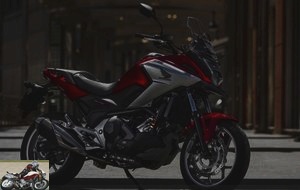
Discovery
Hybrid more or less determined at its origin, the chrysalis on stilts achieves a rather remarkable change in style. Racy and elegant, especially in a two-tone version, the trail adopts the fluid aesthetic of a sporty urban adventurer. Cut in multiple sections, the front is aggressive. Frontal convergence of lines, the openwork spoiler supports an angular optic surmounted by a bubble, always fixed, extended by 7 cm. A central duct equalizes the pressure and openings reduce aerodynamic turbulence. From others, the side surfaces take on volume and structure, adding to the shapes of the sides in long scoops..
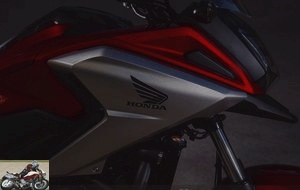
The whole surrounds the tank of tank increased to 22 liters (+ one unit), dressed in sharp volumes. A dedicated barrel placed at the end of this storage now controls its opening. Its hood receives solid and aesthetic integrated rails on the outside for attaching a saddlebag. Internally, 4 hooks allow you to install straps to compartmentalize this space. This can accommodate most full-face helmets and even my "crosser" type helmet (sun visor folded down). If you don’t put it there, it will accommodate a host of other items or rain gear, shoes, etc..
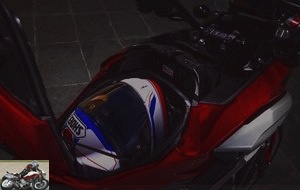
A welcoming double seat extends this muscular front. The passenger seat houses the orifice for the 14.1-liter canister, placed in the nicely sheathed rear loop. Two large handles reserved for the attendant equip this stern with a large fire.
A tubular steel diamond-like frame covers this stylish outfit. It also supports, at arm’s length, the 745 cc 8-valve in-line twin. Indeed, its tilted position 62 ° forward places the unit very low. While this feature effectively pushes the center of gravity down, the visual impact was previously unattractive. But the casing now elegantly masks this characteristic.
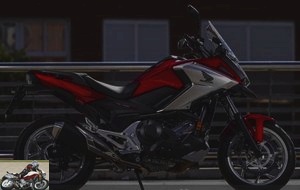
The block carries over other innovative solutions from its beginnings. Mono-injector, single camshaft driving the water pump and two balance shafts, one of which operates the oil pump. The twin is very compact. Crankshaft set at 270 ° and stroke bore ratio of 77 x 80 mm give pride of place to torque and availability. Unchanged, the twin develops 55 hp at 6,250 rpm and a force of 6.8 da.Nm at 4,750 revolutions / minute. This last curve presents a good consistency and especially the essential is present from low revs.

Our trial version accompanies its mechanics with a DCT robotic box with double clutch. 2/3 of sales are rightly for this model. In fact, displaying a reduced range of use from 1,100 to 6,500 rpm, the twin-cylinder of the NC is much more efficient and pleasant under electromechanical control. As a reminder, this box includes two filing clutches. One controls 1/3/5 ratios and the other controls 2/4/6. These two elements work alternately and each is independently controlled by its own electro-hydraulic circuit. When changing gear, the electronic control unit detects the movement of the control and engages the next gear. It then releases the clutch from the previous gear while engaging the gear clutch. The new opus further refines this electronics, thus optimizing both the reactivity and the efficiency of the transitions. Accessible at any time, the use of the + and – selection triggers now allows higher downshifts in the towers (sport mode). The manual modes M, D evolve according to the piloting and, from now on, the three S sport modes are made more precise. The multiplication of these should allow a finer match with the range of possible piloting situations. Finally, a system detects the phases of driving up or down and manages the operation of the selection accordingly.

Another novelty, the exhaust is styled, shorter and loses 0.5 kg. It incorporates two relaxation areas connected by a perforated pipe opening into a resonance chamber. Its faceted volumes are dressed in a strapping and a perforated aluminum side protection. At its side we appreciate the stylish footrest plates, reinforcing the general appearance. Less convincing, the swingarm in rectangular steel profile denotes a bit. Especially since the Integra features an element in aluminum foundry.
The suspension changes significantly. The propulsion train is managed by a Pro-Link type shock absorber, now adjustable in preload and swinging over 150 mm. In contrast, an attractive 41mm Showa Dual Bending Valves (SDBV) telescopic fork equips the steering gear. A double-acting valve system generates a damping force precisely tuned to the speed of the piston. Devoid of adjustment, it nevertheless benefits from an optimized calibration in compression and rebound and offers a travel of 153 mm.
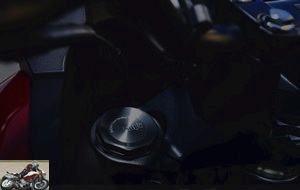
The geometry hardly changes, with a column angle fixed at 27 ° and a trail of 110 mm. Only the wheelbase is reduced to 1,535 mm (against 1,540 predecessor). The standard version weighs 220 kg and our DCT 230 kg, with a weight distribution of 48/52%.
The aluminum rims with bent valves receive Dunlop D609 Trailmax casings or Brisgestone Battlax BattleWing in 120 and 160. Their rotation is under control of front and rear single-disc brake, with petal frets. A dual piston caliper bites the 320mm front track, a single piston element grips the opposing 240mm disc. The whole is in good care of the ABS.
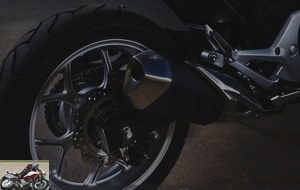
Truly attractive, the general line of NC750X takes the DNA of its elders, but this time benefits from a much more attractive and sporty aesthetic. Sure, there is quite a bit of plastic and covers, but these elements are of good quality. There are also few hoses and cables visible. A large composite shoe protects the engine block and the lighting is now fully LED. Two rows make up the powerful front optic and the indicators feature a smoked finish. We regret the absence of a standard central stand and an adjustable screen. Hand guards, 12 V socket on the dashboard … are also optional.

In the saddle
Welcoming, the trail only raises the pilot’s seat by 830 mm and offers a large saddle with contrasting volumes. The position provided by the handlebar-saddle-footrest assembly is most pleasant. Straight bust, the hands fall on the wide handlebars. Its horns seem to me a little close to the pilot and would have deserved a separation a bit more marked. In front of you, the cockpit is simple, but well thought out. Dominating handlebar bridges and alumite gray fork caps, an LCD screen groups together all the instruments. Tachometer, barograph-type tachometer, gear indicator engaged, clock and fuel gauge permanently accompany the information to choose from: odometers and double trip with each average and instantaneous consumption. Unfortunately, no control on the handlebars. The display color can be adjusted from 9 choices. These can be modified according to the selected speed, the speed range or the driving mode. However, this manipulation is hardly easy or intuitive. Particularly readable in direct sunlight, the screen could benefit from a slightly larger size.

The brake lever is adjustable in spacing and a parking blocking system will sometimes occupy your left hand, punishable by any manipulation of the clutch ….
In the city
The escapement gives off pleasant pulsations in accordance with the new tone of the design. With great smoothness, control and mechanics elegantly take the NC750X DCT through the Spanish streets. In D mode, the electronics take care of fuel consumption and go up quickly enough. Precise and fast, the DCT box is often imperceptible in its operation. At low speed only, we will sometimes hear this robotic selection. Real comfort in urban areas, the Honda automation hardly calls for more criticism in these places. The evolutions gain in simplicity and benefit the agility of the chassis. Lower weight distribution and reduced turning radius give the automatic wader considerable maneuverability between walls. The NC750X fits comfortably in traffic and easily accommodates tight spaces.
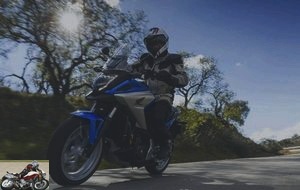
For games, we then try the S1 mode, providing a better motor response. The other variables reinforce the reactions as much, but we gain in liveliness what we lose in serenity. To profitably exploit this more marked temperament, it is necessary to take the broad.
Motorway and expressways
Rather alert, the block takes its turns quickly and just as quickly overtakes the legal motorway. The 170 km / h are quickly reached (maximum 195 km / h) and the stability remains exemplary. Returning to the usual regime, the protection of the bubble still seems to be improved. Arms, shoulders and top of the head are subjected to air flow and turbulence. No problem for 20 or 30 km commuting on expressways, but for a long motorway trip, you will have to go through the option box. However, the position allows to face without fear of longer stages, which it is always preferable to carry out by the secondary network..
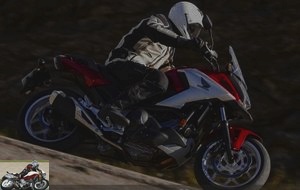
Departmental
Agile and perfectly balanced, the NC750X DCT quickly builds confidence. To give rhythm and stick to our careful opener on the handlebars of an Africa Twin, the S2 mode gives full satisfaction. The trail is steered intuitively, effectively relaunched by a voluntary gearbox / motor unit, if not powerful. On the top of the mountains overlooking Malaga, the asphalt presents large wet spots, quickly giving way to a soggy surface, reducing our pace. Confidently, I don’t pay attention and, foot on the rear brake, quietly tackles a curve to the right…. when the electronics also decide to enter a report. Tires and cold weather, humidity…. the sanction is immediate and the rear casing slips, placing my machine at right angles…. On the brink of falling, however, I got my mount back and quickly deduced two things. The first is that a mechanical gearbox would logically not have put me at fault. But also that, thanks to its very low center of gravity, the NC750X also helped me out of this bad situation (without counting my piloting science, it goes without saying…. Or not). When will the anti-skating save?
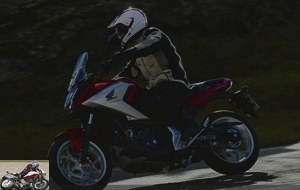
After this little mishap and the asphalt drying quickly, the Honda is then fully expressed. Limited by a mechanism devoted to energy efficiency and daily peri-urban travel, the ecotrail does not forget to be fun and above all efficient. Perfectly guided by a remarkably rigorous front end, the NC750X takes off at a good pace on the rough roads of the Iberian hinterland. Its mounting in 160 at the rear makes it quite playful, also helped by the lever arm of the handlebars. Its new suspensions give it a new ease, particularly its fork with appreciable progressiveness, greatly limiting the transfer of masses. A real good point. The front brake is all the more efficient and controllable, but the simple disc may show some limits on large decelerations at high speed.
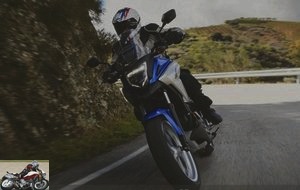
To tease the machine, the S3 mode of the gearbox allows you to benefit from a straightforward response from the twin and perfectly regulated decelerations, almost comparable to the operation of a mechanical gearbox. A real pleasure for weekend outings.
At a discovery pace, the Honda trail is convincing as much by its roundness as the softness of its DCT box. In addition, D mode has the appreciable ability to "learn" your piloting. Understand by this that his analysis allows him to best follow your style. Rather sporty? The electronics will gradually adapt their response to satisfy you and downshift more to ensure better recovery or braking assistance.
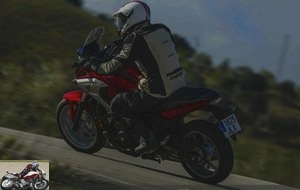
Part-cycle
Healthy, stable and rigorous, the NC750X DCT progresses very significantly in dynamic behavior. Its suspensions provide it with appreciable benefits on any occasion. Rigid and agile, the trail adapts as well to the city as to more open spaces.
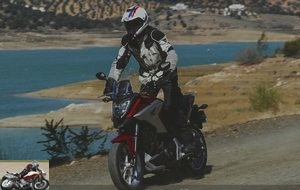
Braking
Completely convincing in solo sport, the whole will be more limited in rapid evolutions in duo. The control is very satisfactory and the rear clamp ideally seconds the front. Likewise, ABS is discreet and its implementation relevant.
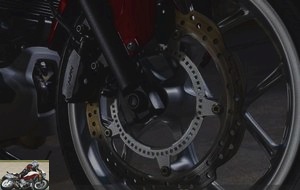
Comfort / Duo
Efficient cushioning and welcoming saddles make the Honda suitable for long trips and duos. The accompanying person is neat, with low-placed footrests and generous grab handles.
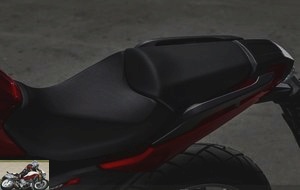
Consumption
4.2 liters per 100 km is our average consumption, at a faster rate than normal use. On daily commuting, this value can easily drop by half a liter.
Conclusion
With its air of a dynamic adventurer, the new Honda NC750X creates a personality of everyday seductress. Efficient on the road and pleasant from day to day, trail running is a charming companion. The consumer argument is therefore no longer its only quality. Aesthetics, almost flawless DCT gearbox and engine approval linked to this technology transcends the model. The main criticism is the lack of traction control, which is as essential in urban areas as it is for the wheels. A remark which put the Japanese engineers in a positive embarrassment, because they seem finally well aware of the importance of this assistance…. To be continued.
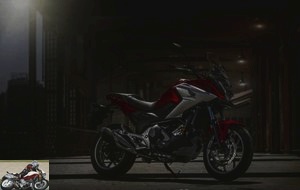
When it was launched, the NC 700 X C-ABS was offered at € 6,490, in 2014 at € 7,199 (€ 7,999 in DCT version), but without C-ABS…. The novelty now passes the bar of eight thousand euros in DCT version: € 8,299 and appears at € 7,499 in mechanical gearbox. Its crotch and trim are the main cause. But also the reasons for all the interest you might have in it.
Strong points
- Seductive style
- Engine character and availability
- Exhaust sound
- Agility and precision of the chassis
- Comfort
- Finishes
Weak points
- Non-adjustable screen
- Lack of anti-slip
- Automation in extreme situations
The technical sheet of the Honda NC750X
Availablity
- March 2016
Colors
- Matt Pearl Glare White
- Candy Arcadian Red
- Sword Silver Metallic
- Matt Gunpowder Metallic
- Glint Wave Blue Metallic
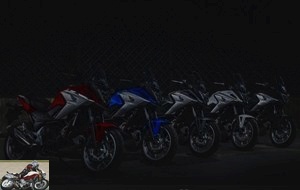
Accessories
- Luggage rack
- Hand guards
- Top case 45 L
- 29 L side cases
- Inner bags
- Central stand
- Fog lights
- Protective structure
- Heated grips
- 12V socket
- U-lock
Related articles
-
Two-wheeler SUV or land-based backpacker Recognized supplier of sometimes avant-garde innovations and yet producing machines regularly considered very…
-
The migratory meaning The spirit of adventure certainly blows through the 2012 motorcycle production. Indeed, no less than three new maxi-trails come to…
-
Efficient charmer Alongside its NC700s (New Concept), Honda presented in 2012 a hybrid machine, very close in part-cycle and mechanical parts of its…
-
Road bike 173 horses Presented in early 2010 as the synthesis of Honda know-how, both mechanically, qualitatively and technologically, the VFR 1200 did…
-
Honda Africa Twin CRF1000L test
Honda CRF1000L Africa Twin ABS and DCT version Legends never die. Like the phoenix, the Africa Twin is reborn from the sand of its past exploits in a…
-
Honda Integra 750 maxi-scooter test
The biker scooter Apply to the motorcycle what the manufacturer was already doing for the car…. that is to say use a common base to decline several…
-
Honda NC 700 X motorcycle test
Transgenic camel Discovered at the Milan Motor Show, the Honda range is enriched with a new range of 3 midsize machines, available on the same chassis…
-
Honda GoldWing GL1800 DCT motorcycle test
An armchair for two, luxury cruise, Mobile lounge 6 cylinders flat, 1,833 cm3, 126 hp and 170 Nm, Tour and standard version (bagger), from € 27,899 to €…
-
Honda CBR 1000 RR Fireblade test
The era of e-Total Control A quarter of a century has seen the evolution of one of the most efficient and unique sports cars in the segment: the CBR…
-
GT-Cruiser of the 3rd type The winged builder keeps up his ideas and keeps revisiting the contemporary bagger style. After the F6B and very soon F6C,…
thank you for this article.
for the bubble, the f850 adventure has already been flashed by your colleagues during tests with a real high bubble … so, a plexi penuri may explain that, or BMW wants us to wait every few months to order a motorcycle finally finished with a minimum of protection like all its competitors ?
a test planned for the 750? may be more suitable for A2 city dwellers?
Thank you fastboni for the glowing comments (and I note for the increase). David ?
@Jepp: the F 750 GS test online in the morning on Le Repaire…
thank you for following us
Philippe
Anti-skating is an obvious safety. Especially if we turn the handle a little hard.
The new NC750X is comfortable and dynamic because its suspension is homogeneous and remarkable (for this range) on the front axle thanks to its new fork..
A new test is needed…
Indeed, there is something to hesitate about! The Triumph will be more comfortable, more equipped, more road. The BMW a little more fun. Tell us what will be your choice
Philippe
thank you for testing the 750. The two bikes are A2 …. I have already been advised to use the 750 but BMW tells me that the 850 clamping will be more torque … an idea ?
I understand that the pro qhifter is not a necessity (750 or 850). I have a 90% city use but the heart goes on the spoke wheel look …. am I stupid?
As for ecall, here is the explanation in concession:
1) the motorcycle is able to determine that an accident has taken place (gyro-accelero) and a physical person will call you through the ecall button which has a micro and a miniaturized speaker .
if you do not answer this call, the operator will call the emergency services with your geolocation.
2) if you need help or if you witness an accident that requires emergency intervention, you can press your e-call to be put in contact with a person who can call for help.
I find the option interesting, in metropolitan use.
@Jepp: the clamping will be identical on the two versions because the engine is the same: it will be 48 hp and 63 Nm at 4500 rpm in both cases, and it will therefore be the most torquey 750 because it is the least heavy. By a simple reprogramming of the mapping, you can even have the performance of the 850 in the 750 (obviously, this is prohibited and it is not the BMW network that will do it for you!).
As for the e-call, it will become mandatory in all new cars soon and this approach will undoubtedly be generalized to motorcycles in the process….
Philippe
It is quite paradoxical to find an interesting option on a trail, whereas a Trail is rather made to go for a walk on small roads and paths, where there is precisely no network for telephones and therefore that these gadgets are strictly useless.
Personally, I would absolutely not want it on a bike of this damn Ecall!